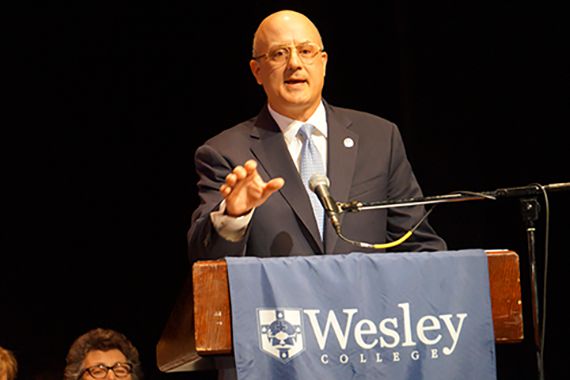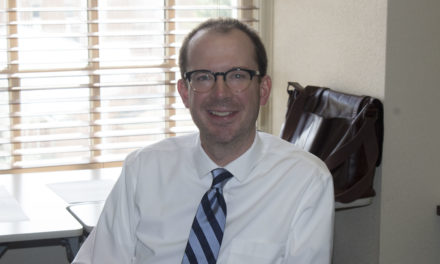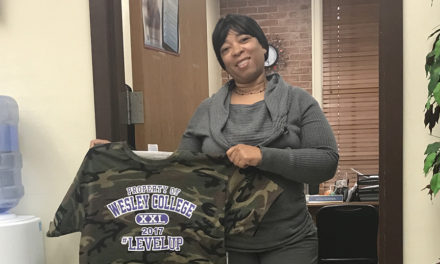By Adriane Fraser and Kristen Griffith, The Whetstone
A week of events preceded a college-wide celebration of the inauguration of the 17th president of Wesley College, President Robert Clark, on March 23.
“At the end of the day, it wasn’t about an individual,†Clark said. “It was the celebration of who we are as a Wesley College family.â€
Clark said having the students, staff and faculty to help him celebrate was his favorite part of Inauguration week.
The College’s annual Founder’s Day March 17 kicked off the week, followed by a community service project at Bennett Chapel the following day.

President Robert E. Clark
A March 21 lecture about Annie Jump Cannon was followed the next day by the dedication of the sculpture in the South Plaza for the previous president and his wife, Mr. and Mrs. William Johnston. The same afternoon, a College Center third floor art exhibit opened, and, later that evening, many attended a worship service.
Founder’s Day was the first event to begin inauguration week.
Students sat with their donors for lunch at Clark’s residence, the Annie Cannon Jump House. Afterward, students joined the rest of the recipients at the Schwartz Center for the Arts where they walked across the stage and received their scholarships and awards.
“I received the ($1,500) Richard Paul Pepper Scholarship,†said junior Lily Lindstrom.
She was impressed by the ceremony.

Lily Lindstrom
“It was more than I expected, honestly, so I was really appreciative of it,†she said.
Students, faculty, staff and members of the community gathered in the South Plaza for the sculpture dedication March 22.
Wesley Society member, Rosemary Twilley dedicated the abstract sculpture “Equivalence,†– big blue curves of steel mounted on top of one another – to honor the Johnstons.
“I felt that the Johnstons brought a great deal to the art community in Delaware,†she said.
Johnston said he and Susan were pleased with the sculpture.
“I think it will be a longstanding item that the community can appreciate,†he said.
The artist, Edgar Twilley, started out with a 10 foot piece of steel I-beam.
“How can I make it come to life,†Twilley said he asked himself. “This is still that 10-foot piece of I-beam that’s been cut, heated, bent and reshaped.â€

Dr. William Johnston, Susan Johnston, Edgar Twilley and Rosemary Twilley
He said nothing was added or taken away; it’s still the same piece of steel he started with.
“Now, every length is curved, so it comes alive in a surprising way,†he said. “It’s almost dancing and kind of fluttering, and that’s the goal.â€
Twilley said he was challenged with making it interesting.
“To have a nonrepresentational form that people look at and go ‘Huh, that’s interesting,’ and they don’t even know why,†he said. “To me that’s the best compliment.â€
The audience migrated to the third floor and viewed Visiting Assistant Professor of Art Sarah Hardesty’s art exhibit, “The Fall and Rise.†Her exhibition included drawings, paintings and mixed media.
“Though it was an exhibit, it highlighted the talent of one of our remarkable professors,†Clark said about Hardesty’s “The Fall and Rise.†“It also opened the door providing the opportunities for our students right here within the community.â€
The last event of the week was the inauguration ceremony itself.
Members of Wesley College processed into the Schwartz Center in their caps and gowns to the sound of the First State Brass Ensemble.
The Dover Air Force Base Color Guard marched on stage and held the American flag during the National Anthem.
After Reverend Scot McClymont’s prayer, Chair of Wesley College’s Board of Trustees Robert Harra introduced the speakers of the ceremony: Student Government President Savannah Durham, Psychology Professor and Faculty Convener Dr. Angela D’Antonio, Director of Academic Support Christine McDermott, President of the Alumni Association Kirsten Higgins, Dover City Council President Timothy Slavin, Bishop Peggy Jackson and Governor Jack Markell.
The final speech came from Clark.
One of the themes of his speech was the importance of a liberal arts education over vocational training.
“Education is not just about ‘job training’ if all we do is train to task,†he said. “We will fill an immediate, and select need, but we will fail to provide the basis for future growth, awakening, and discovery….We should be proud of the fact that we are the oldest and smallest private college in Delaware, but we should not constrain our potential, or bound our pride in the past.â€





